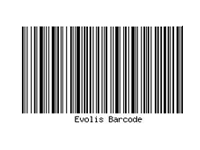Barcodes
A bar code is the first-level encoding option for plastic cards, and it is the most widely used method as well. Graphical encoding is performed as the badge is being printed.
What is a bar code?

A bar code is a machine-readable representation of numeric or alphanumeric data in the form of a symbol consisting of bars and spaces. Bar code widths and spacings vary according to the encoded data and to the encoding standard that is used.
Bar codes are read by a photosensitive electronic scanner. Such a scanner, when reading a bar code, detects high and low reflectance of the bar code printed on the plastic card, using the principle of light reflection and absorption: rays are reflected by the light areas of the bar code and are absorbed by the darker areas.
The printed bar code must, therefore, display a high level of contrast between the two types of areas, while outlines must be even and sharp.
How to print bar codes on a plastic card?
The Evolis printers affix bar codes on plastic cards, thanks to their thermal transfer technology. This technology optimizes the contrast level and printing precision so that bar codes are seamlessly read by optical scanners.


